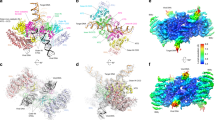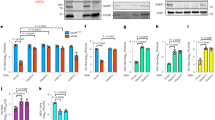Abstract
T ANTIGEN of simian virus 40 (SV40) is the product of the A gene of the virus1 and has been shown to have a role in the establishment and maintenance of transformation2–5. T antigen has also been shown to be required for the initiation of each round of viral DNA synthesis6 and for induction of host DNA synthesis7–11. Furthermore, it has been suggested that T antigen may initiate DNA synthesis in transformed cells and thereby help maintain those cells in the transformed state6,12–14. The SV40 genome has three preferential binding sites for T antigen, one of which is at or near the site at which viral DNA synthesis is initiated15. The binding of T antigen to eukaryote DNA is less well defined but shows a preference for double-stranded over single-stranded DNA16. Similar findings have been reported for tumour-specific transplantation antigen17. SV40 nucleohistone has also been reported to bind T antigen in amounts threefold greater than does native SV40 DNA18. To investigate the role of T antigen in the regulation of the host cell, we have asked whether host chromosomes bind detectable amounts of T antigen; and, if so, whether the binding is restricted to specific chromosomes or to specific chromosomal loci. Although earlier studies have suggested that T antigen is associated with nuclear chromatin of infected cells19, this study is the first to report the binding of SV40 T antigen to mammalian chromosomes.
This is a preview of subscription content, access via your institution
Access options
Subscribe to this journal
Receive 51 print issues and online access
$199.00 per year
only $3.90 per issue
Buy this article
- Purchase on Springer Link
- Instant access to full article PDF
Prices may be subject to local taxes which are calculated during checkout
Similar content being viewed by others
References
Rundell, K., Collins, J. K., Tegtmeyer, P., Ozer, H. L., Lai, C.-J. & Nathans, D. J. Virol. 21, 636–646 (1977).
Tegtmeyer, P. J. Virol. 15, 613–618 (1975).
Martin, R. G. & Chou, J. Y. J. Virol. 15, 599–612 (1975).
Brugge, J. S. & Butel, J. S. J. Virol. 15, 619–635 (1975).
Osborn, M. & Weber, K. J. Virol. 15, 636–644 (1975).
Tegtmeyer, P. J. Virol. 10, 591–598 (1972).
Chou, J. Y. & Martin, R. G. J. Virol. 15, 145–150 (1975).
Fox, R. O. & Levine, A. J. J. Virol. 7, 473–477 (1971).
Gershon, D., Sachs, L. & Winocour, E. Proc. natn. Acad. Sci. U.S.A. 56, 918–925 (1966).
Henry, P., Black, P. H., Oxman, M. N. & Weissman, S. M. Proc. natn. Acad. Sci. U.S.A. 56, 1170–1176 (1966).
Smith, H. S., Scher, C. D. & Todaro, G. J. Virology 44, 359–370 (1971).
Martin, R. G., Chou, J. Y., Avila, J. & Saral, R. Cold Spring Harbor Symp. quant. Biol. 39, 17–24 (1974).
Martin, R. G. & Oppenheim, A. Cell 11, 859–869 (1977).
Oppenheim, A. & Martin, R. G. J. Virol. 25, 450–452 (1978).
Jessel, D., Landau, T., Hudson, J., Laxlor, T., Tenen, D. & Livingston, D. M. Cell 8, 535–545 (1976).
Carroll, R. B., Hager, L. & Dulbecco, R. Proc. natn. Acad. Sci. U.S.A. 71, 3754–3757 (1974).
Chang, C., Luborsky, S. W. & Mora, P. T. Nature 269, 438–440 (1977).
Persico-Dilauro, M., Martin, R. G. & Livingston, D. M. J. Virol. 24, 451–460 (1977).
Leduc, E. H., Wicker, R., Avrameas, S. & Bernhard, W. J. gen. Virol. 4, 609–614 (1969).
Wurster, D. H. & Benirschke, K. Science 168, 1364–1366 (1970).
Chen, T. R. Expl Cell Res. 104, 255–262 (1977).
Brown, S., Teplitz, M. & Revel, J.-P. Proc. natn. Acad. Sci. U.S.A. 71, 464–468 (1974).
Diacumakos, E. G. & Gershey, E. L. J. Virol. 24, 903–906 (1977).
Klevecz, R. Analyt. Biochem. 49, 407–415 (1972).
Hsu, T. C. in Tissue Culture Methods and Applications (eds Kruse, P., Jr. & Patterson, M. K.) 764–767 (Academic, New York, 1973).
Korf, B. & Diacumakos, E. G. Expl Cell Res. 111, 83–93 (1978).
Robb, J. A. in Tissue Culture Methods and Applications (eds Kruse, P., Jr & Patterson, M. K.) 517–524 (Academic, New York, 1973).
Author information
Authors and Affiliations
Rights and permissions
About this article
Cite this article
D'ALISA, R., GERSHEY, E. Simian virus 40 T antigen binds to host cell chromosomes. Nature 274, 164–166 (1978). https://doi.org/10.1038/274164a0
Received:
Accepted:
Issue Date:
DOI: https://doi.org/10.1038/274164a0
This article is cited by
Comments
By submitting a comment you agree to abide by our Terms and Community Guidelines. If you find something abusive or that does not comply with our terms or guidelines please flag it as inappropriate.



